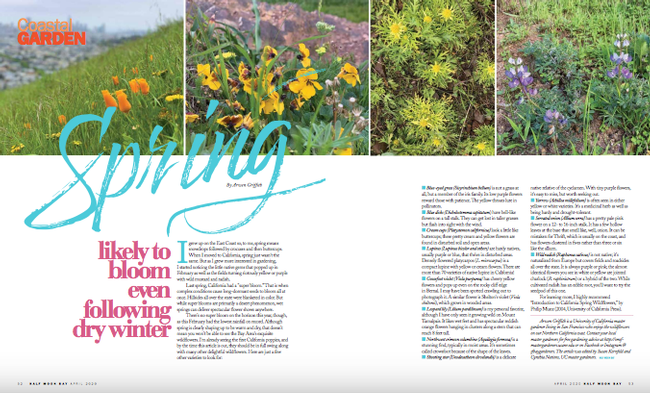I grew up on the East Coast, so for me, spring means snowdrops followed by crocuses and then buttercups. When I moved to California, spring just wasn't the same. But as I grew more interested in gardening, I started noticing the little native gems that popped up in February as well as the fields turning riotously yellow or purple with wild mustard and radish.
Last spring, California had a "super bloom," where complex conditions cause long-dormant seeds to bloom all at once. Hillsides all over the state were blanketed in color. But while super blooms are primarily a desert phenomenon, wet springs can deliver spectacular flower shows anywhere.
There's no super bloom on the horizon this year, though, as this February had the lowest rainfall on record. But although spring is clearly shaping up to be warm and dry, it doesn't mean you won't be able to see the Bay Area's exquisite wildflowers. I'm already seeing the first California poppies, and by the time this article is out, they should be in full swing along with many other delightful wildflowers. Here are just a few other varieties to look for:
- Blue-eyed grass (Sisyrinchium bellum) – it's not a grass at all, but a member of the iris family, its low purple flowers reward those with patience. The yellow throats lure in pollinators.
- Blue dicks (Dichelostemma capitatum) have bell-like flowers on a tall stalk. They can get lost in taller grasses but flash into sight with the wind.
- Cream cups (Platystemon californicus) look a little like buttercups; these pretty cream and yellow flowers are found in disturbed soil and open areas.
- Lupines (Lupinus bicolor and others) are hardy natives, usually purple or blue, that thrive in disturbed areas. Dense-flowered platycarpos (L.microcarpus) is a compact lupine with yellow or cream flowers. There are more than 70 varieties of native lupine in California!
- Goosefoot violet (Viola purpurea) has cheery yellow flowers and pops up even on the rocky cliff edge in Bernal. I may have been spotted crawling out to photograph it. A similar flower is Shelton's violet (viola sheltonii), which grows in wooded areas.
- Leopard lily (Lilium pardilinum) is my personal favorite, although I have only seen it growing wild on Mt. Tamalpais. It likes wet feet and has spectacular reddish orange flowers hanging in clusters along a stem that can reach 8 feet tall.
- Northwest crimson columbine (Aquilegia formosa) is a stunning find, typically in moist areas. It's sometimes called crowsfoot because of the shape of the leaves.
- Shooting star (Deodecatheon clevelandii) is a delicate native relative of the cyclamen. With tiny purple flowers, it's easy to miss, but worth seeking out.
- Yarrow (Achillea millefolium) is often seen in either yellow or white varieties. It's a medicinal herb as well as being hardy and drought-tolerant.
- Serrated onion (Allium serra) has a pretty pale pink flower on a 12-16 inch stalk. It has a few hollow leaves at the base that smell like, well, onion. It can be mistaken for Thrift, which is usually on the coast, and has flowers clustered in fives rather than three or six like the allium.
- Wild radish (Raphanus sativus) is not native; it's naturalized from Europe, but covers fields and roadsides all over the state. It is always purple or pink; the almost identical flowers you see in white or yellow are jointed charlock (R. raphinistrum) or a hybrid of the two. While cultivated radish has an edible root, you'll want to try the seedpod of this one.
For learning more, I highly recommend Introduction to California Spring Wildflowers, by Philip Munz (2004, UC Press).
Arwen Griffith is a UC Master Gardener living in San Francisco who enjoys the wildflowers on our northern California coast. Contact your local Master Gardeners for free gardening advice at http://smsf-mastergardeners.ucanr.edu or on Facebook or Instagram @sfbaygardeners. The article was edited by Susan Kornfeld and Cynthia Nations, UC Master Gardeners.
Attached Images:
